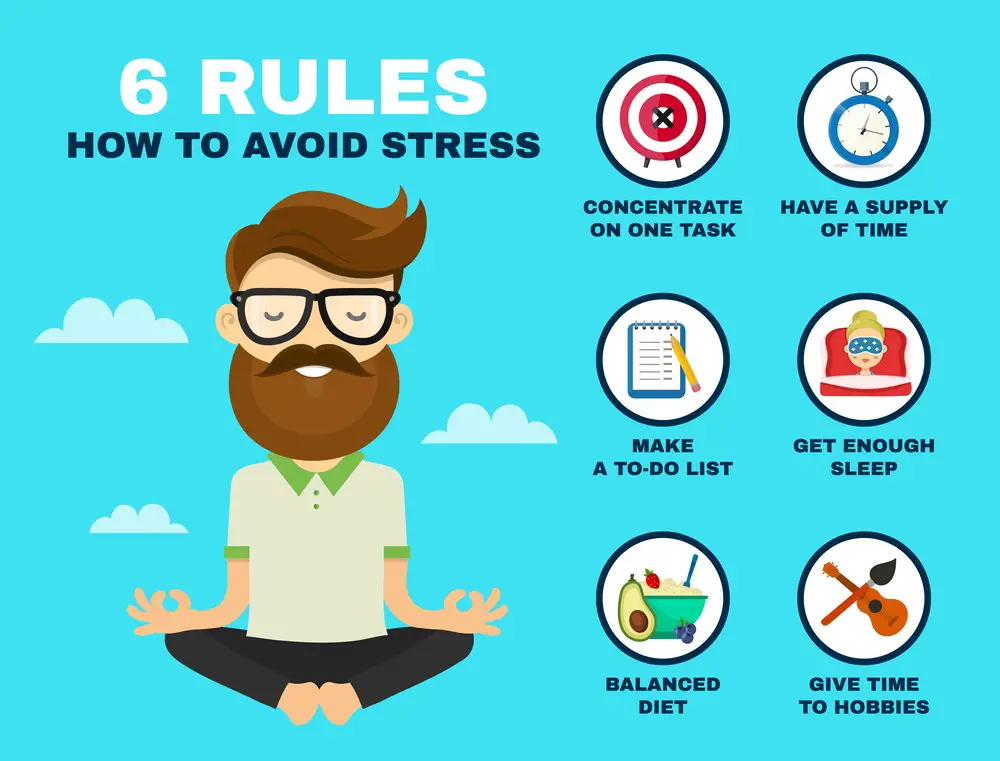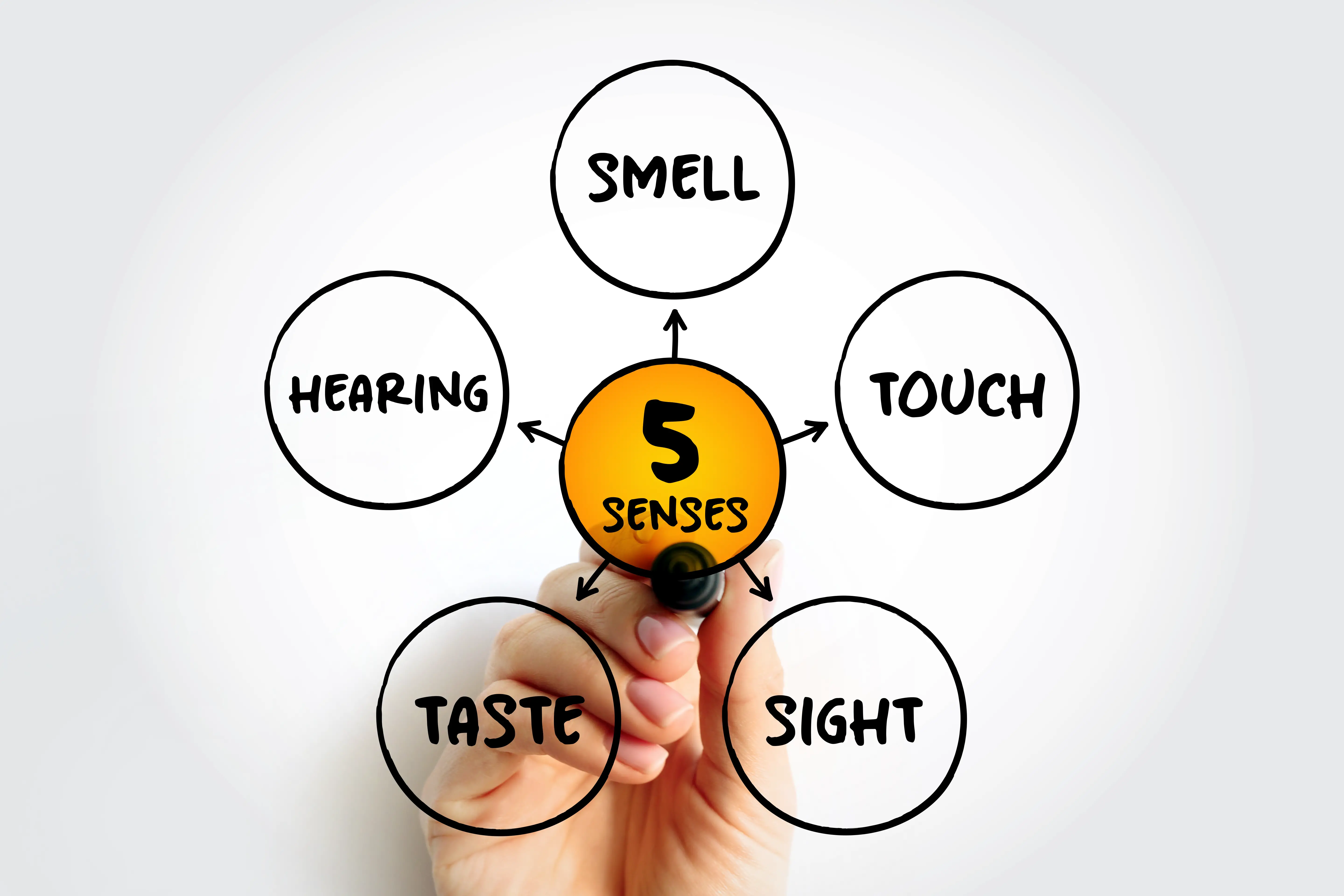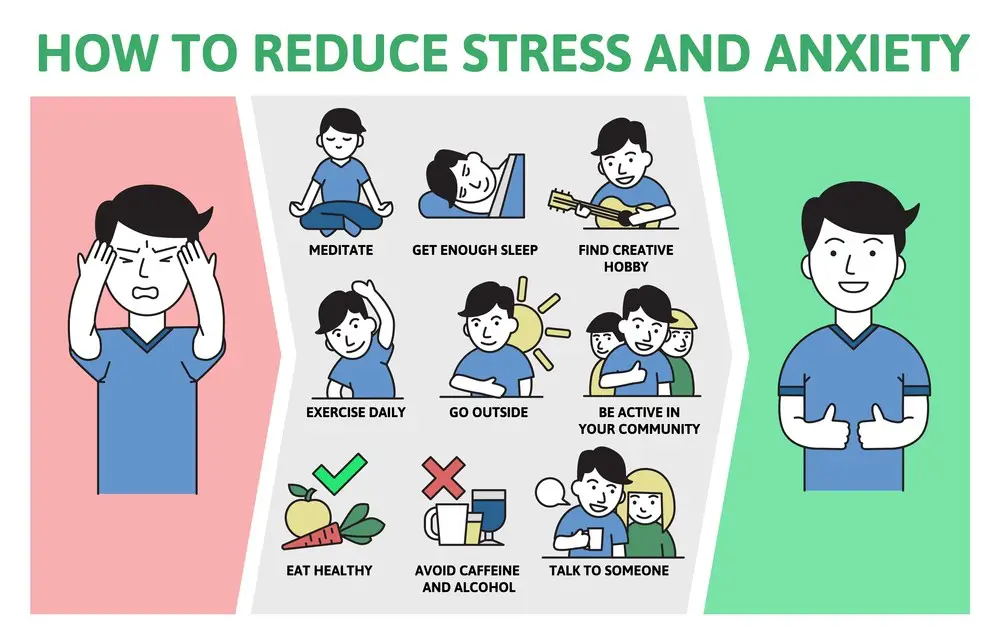As a BetterHelp affiliate, we receive compensation from BetterHelp if you purchase products or services through the links provided
To help you manage stress effectively, we’ve gathered six self-soothing techniques from professionals like psychotherapists and mental health counselors. Discover the methods these experts recommend for maintaining mental tranquility, from the progressive muscle relaxation technique to the sensory grounding technique for tranquility.
- Progressive Muscle Relaxation Technique
- “Five Senses” Grounding Exercise
- Vagal Toning for Calmness
- “5-4-3-2-1” Grounding Technique
- Deep Breathing for Stress Management
- Sensory Grounding Technique
 1. Progressive Muscle Relaxation Technique
1. Progressive Muscle Relaxation Technique
I love teaching my clients about Progressive Muscle Relaxation. It helps us recognize we can respond to stress and tension in our bodies.
We start by tensing parts of our bodies, starting at the feet and working our way up to the face. We hold the tension for a few seconds; then we release the tension and experience relaxation. This is similar to how we experience “fight or flight” in a stressful situation and then move into a state of “calm and connected” when we want to experience a soothing sensation.
Amanda Marks, Psychotherapist, Resilient Counseling
 2. “Five Senses” Grounding Exercise
2. “Five Senses” Grounding Exercise
As a mental health therapist, a self-soothing technique that I always recommend to clients is the “Five Senses” exercise, given its efficacy and ability to be used anywhere. This technique is used for grounding oneself when dealing with stress and anxiety.
The exercise entails identifying five things you can see, four things you can touch, three things you can hear, two things you can smell, and one thing you can taste. For example, I often use this in my office, which looks like the following:
I notice the door, window, desk, chair, and tissues.
I am touching my sweater, hair, necklace, and armchair.
I am hearing the cars, birds, and noise machine.
I am smelling my candle and my lunch.
I am tasting my coffee.
I highly recommend trying this technique to shift your focus to the present moment rather than having your stress overwhelm your thoughts!
Taylor Chodash, Mental Health Counselor, LP
3. Vagal Toning for Calmness
One of my favorite self-soothing techniques I teach my clients and use myself is vagal toning.
This technique allows us to activate the calming response in our nervous system through the vagus nerve, the largest cranial nerve that runs from our brain to our bodies. The vagus nerve is an information superhighway between our brains and bodies, allowing us to rebalance quickly or “tone” our sense of well-being and ground ourselves in the present.
By making contact with a few specific touchpoints on our face, ears, head, chest, and abdomen, we can access and strengthen our mind-body capacity for flexibility in managing the stress that life sometimes gives us.
Christie Pearl, EMDR Therapist and Consultant, Christie Pearl, LMHC, LPC
4. “5-4-3-2-1” Grounding Technique
One of my favorite techniques is the “5-4-3-2-1 Grounding Technique.” It’s rooted in mindfulness and helps anchor you to the present moment. Here’s how it works:
- Identify five things you can see around you.
- Touch four different objects and notice their texture.
- Listen for three distinct sounds.
- Identify two different scents.
- Taste something or notice the current taste in your mouth.
This method is very effective during stressful moments when you feel overwhelmed or anxious, as it helps pull you out of spiraling thoughts, keeping you grounded, allowing you to regain clarity, and making clear-headed decisions.
Bayu Prihandito, Certified Psychology Expert, Life Coach, Founder, Life Architekture
5. Deep Breathing for Stress Management
One effective self-soothing technique for managing stress is deep breathing or diaphragmatic breathing.
To practice, find a quiet space, sit or lie straight back, and place your hands on your abdomen. Inhale slowly through your nose for a count of four, allowing your abdomen to rise as you fill your lungs. Hold your breath for a count of four, then exhale slowly through your mouth for a count of four, focusing on emptying your lungs. Repeat for 5-10 minutes.
Deep breathing is a simple yet powerful self-soothing technique for immediate and long-term stress management.
Cecil Bennett, Primary Care Provider, Newnan Family Medicine
6. Sensory Grounding Technique
To effectively manage stress, engage your senses in self-soothing practices. Utilize the Sensory Grounding Technique to bring tranquility to your mind and body. Implement the following techniques:
- Visualize: Imagine peaceful things like nature or beautiful art. For example, look at a calming beach picture to calm your mind and reduce anxiety.
- Auditory Bliss: Listen to relaxing music or nature sounds. Hearing the sound of rain or gentle music can help you relax and forget about stress.
- Tactile Comfort: Give yourself a gentle massage or wrap up in a soft blanket. Massaging your head or cuddling in a cozy blanket can make your body feel better.
- Savor Flavor: Eat mindfully and enjoy calming drinks like herbal tea. Sipping chamomile tea slowly can be a comforting habit that relaxes your body and mind.
- Aroma Serenity: Use nice scents or smell fresh flowers. Breathing in the soothing smell of lavender oil can calm you down and make you less restless.
Umayr Azimi, Medical Director, MI Express Care
 Quick Summary:
Quick Summary:
- Progressive Muscle Relaxation: Tune in and release body tension systematically.
- “Five Senses” Exercise: Engage all your senses for instant grounding.
- Vagal Toning: Connect your mind and body through specific touchpoints.
- “5-4-3-2-1” Grounding: A simple mindfulness-based method to pull you back to the present.
- Deep Breathing: Channel your inner Zen with timed inhalations and exhalations.
- Sensory Grounding Technique: A multi-sensory experience that helps you find your chill.
Self-Soothing as Self-Love
Hey, taking care of yourself isn’t selfish; it’s essential. You can’t pour from an empty cup, right? So, find a quiet moment in your day to test these techniques and see what resonates with you. Feel free to mix and match or create a self-soothing playlist tailored just for you.
Tracking Your Progress
So, how do you know it’s working? Keep a “Stress Journal” to jot down:
- Before and After Mood Ratings: On a scale from 1-10.
- Physical Symptoms: Did that tightness in your chest subside? Jot it down.
- Thought Patterns: Notice any shift in your thoughts? Write that too.
- Situational Context: Was it a work meeting or a family drama that frazzled you?
- What Worked: Was the deep breathing or sensory grounding that did the trick?
Reviewing your journal entries can provide valuable insights. They can guide you to tweak or lean into specific techniques, depending on what’s most effective for you.
It’s a Process, Not a Quick Fix
Improving your stress management is a journey. It’s okay if these techniques don’t give you immediate results. They are tools in your self-care toolkit, and it might take some time to feel their full benefits.
 Time for a Pro? Signs You Might Need Expert Help with Stress Management
Time for a Pro? Signs You Might Need Expert Help with Stress Management
Sometimes, life’s challenges can feel like a mountain you can’t climb, no matter how many self-soothing techniques you try. So, how do you know when it’s time to seek help from a professional? Let’s take a look at some telltale signs:
Persistent Stress or Anxiety
- Long-Term Suffering: If stress and anxiety are your unwanted BFFs, hanging around for weeks or months is a red flag.
- Chronic Physical Symptoms: Muscle tension, headaches, or digestive issues that won’t go away. It could be stress-related.
Decline in Day-to-Day Functioning
- Social Withdrawal: You’re avoiding friends and family like they’re spoilers for your favorite show.
- Work Struggles: Difficulty concentrating, missing deadlines, or not being stellar at work.
Unhealthy Coping Mechanisms
- Overindulging: Drowning sorrows in ice cream is one thing; reliance on alcohol, drugs, or food is another.
- Escapist Behavior: Excessive binge-watching, online shopping, or sleep could be avoidance tactics.
Emotional Red Flags
- Mood Swings: One minute, you’re up; the next, you’re down. Emotional inconsistency can be a sign.
- Hopelessness: If you’re feeling trapped, and it seems there’s no way out, that’s a serious signal you should not ignore.
Your Gut Says So
- Trust your instincts. You’re probably right if you have a hunch that you need help.
If any of these signs resonate with you, consulting a healthcare provider for a professional diagnosis and treatment plan might be beneficial. You don’t have to navigate the maze of stress management alone; sometimes, it takes a village—or at least a trained therapist—to help you find your way. Remember, seeking help is a sign of strength, not weakness. So, if you’re struggling, don’t hesitate to reach out.

A Roadmap to Calm: Setting Goals and Tracking Progress in Stress Management Therapy
Now that you’ve recognized the signs and decided to seek professional help, the journey towards a less stressful life can begin. But how do you make the most out of your time in therapy? Goal-setting and tracking your progress can act as your roadmap to mental tranquility. Here’s how to make it effective:
Setting SMART Goals for Stress Management
- Specific: Be crystal clear about what you want to achieve. Instead of saying, “I want to be less stressed,” aim for something like “I want to sleep through the night without waking up anxious.
- Measurable: Attach a number or a frequency to your goal, like “I aim to take three 5-minute breaks during my workday to practice deep breathing.”
- Achievable: Let’s be real, Rome wasn’t built in a day. Set goals that are within reach.
- Relevant: Ensure your goals align with your bigger life aims. If you value family time, a goal could be “managing work stress to enjoy weekends with the family fully.
- Time-bound: A deadline creates urgency. “In one month, I’d like to meditate for 20 minutes without interruption.”
Tools to Track Your Progress
- Therapy Journal: Documenting your therapy sessions, emotions, and revelations can provide invaluable insights.
- Mood Tracking Apps: Numerous apps are designed to help you track your emotional ups and downs. You can share this data with your therapist.
- Check-In Sessions: Use your sessions to gauge where you are versus where you’d like to be. Your therapist can provide an objective viewpoint.
Celebrate the Wins, However Small
- Did you go through a work presentation without breaking into a cold sweat? High-five yourself!
- Manage to take some deep breaths before reacting to a stressful email? Give yourself some credit!
Reassess and Adapt
- If you’re not making as much progress as you’d like, don’t hesitate to reassess your goals. It’s a journey, and it’s okay to take some detours.
Therapy isn’t just a space to unload your emotional baggage—it’s a place to work towards a better, less stressed you actively. Setting SMART goals and keeping tabs on your progress will make your therapy sessions more productive and enjoy the rewarding journey of seeing how far you’ve come. After all, every step forward is a step away from the stress holding you back.
About Jacob Maslow
After surviving the traumatizing events of 9/11, I took it upon myself to heal through helping others. I’m the primary caregiver of my children and understand from first-hand experience the lonely paths you have to walk as a partner and parent when leaving an unhealthy relationship.
We’re all echoing in a dark space that doesn’t have to be this empty, and that’s been my mission since finding solace and recovery in therapy: To help comfort others who are still in shock and at the prime of their struggle.
I came across BetterHelp after searching for this type of community. I wanted to belong to a body of proactive therapists and supportive therapy veterans that allowed me to see other sides of the story.
It was unconventional, and that’s what attracted me most. During my most challenging times, when my ex-wife completely cut me off from my children, I found comfort and clarity through BetterHelp.
Instead of being chained to a strict therapist recommendation, I was in charge of who I felt understood my struggle most. That allowed me to find my true peace, as I was reunited with those who read behind my words and had first-hand experience with my trauma.
Recovery is a choice; with BetterHelp, that choice will be a few clicks away. You can join their couples-oriented platform, Regain.us for those stuck with family estrangement and toxic relationship patterns.
- Breaking the Silence: Why Men’s Mental Health Matters More Than Ever - April 15, 2025
- How to Transform a Home’s Patio Space into a Relaxing Space - March 23, 2025
- 5 Strategies to Use a Cell Phone to Help Manage Your Stress - March 23, 2025
This site contains affiliate links to products. We will receive a commission for purchases made through these links.


 1. Progressive Muscle Relaxation Technique
1. Progressive Muscle Relaxation Technique 2. “Five Senses” Grounding Exercise
2. “Five Senses” Grounding Exercise Quick Summary:
Quick Summary: Time for a Pro? Signs You Might Need Expert Help with Stress Management
Time for a Pro? Signs You Might Need Expert Help with Stress Management
